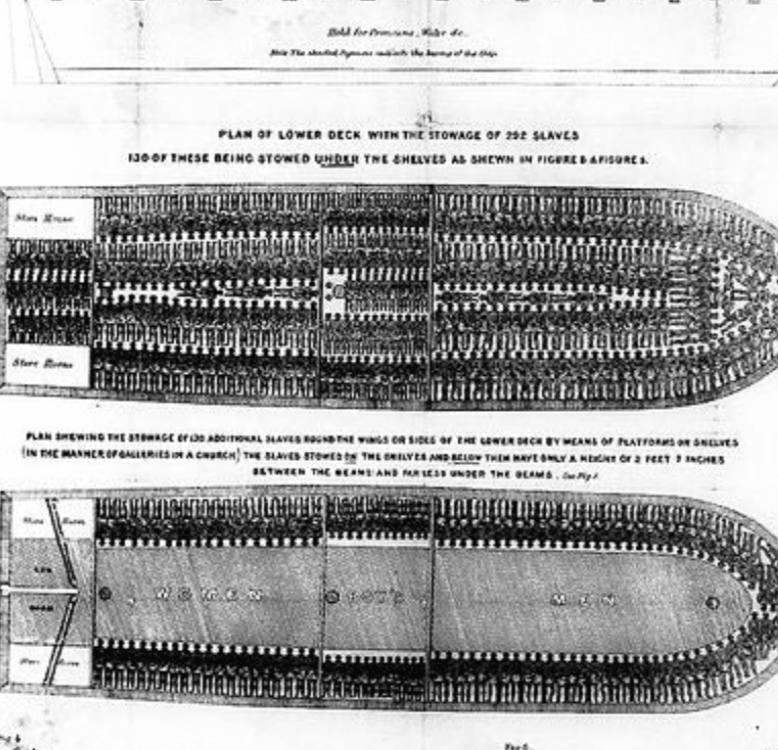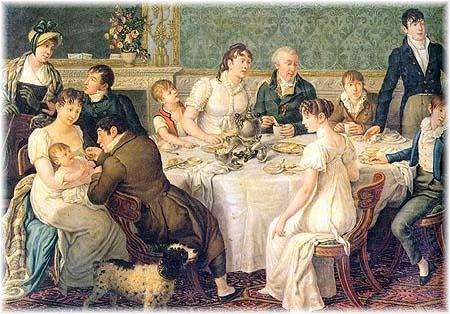
A History of Haiti and Regency Slavery
Apart from a few comments scattered throughout her books, and the plantation in Antigua that finances the running of Mansfield Park, Jane Austen manages to keep all mention of slavery from her work. Avoiding the topic as she did with the many wars waged throughout her writing career, she chooses, rather, to focus on "three or four families in a country village". This ability to write without dipping into the deeper social issues of her time have helped keep her works feeling current and fresh. Still, the issue of slavery was a hot topic during her day.
1789 poster depicting the plan of the British ship Brookes
When, in Emma, Jane Fairfax mentions "There are places in town, offices, where inquiry would soon produce something—Offices for the sale—not quite of human flesh—but of human intellect", Mrs. Elton replies, "Oh! my dear, human flesh! You quite shock me; if you mean a fling at the slave-trade, I assure you Mr. Suckling was always rather a friend to the abolition."
One tends to think that Jane was also a "Friend to the abolition", if Fanny Price's feelings on the subject are meant to be any reflection of her own. Many in Austen's own circle of family and friends fought for the rights of slaves. These included her brothers in the Navy, as well as several of her favorite authors, such as William Cowper, Doctor Johnson and Thomas Clarkson.
In 1792 the House of Commons voted in favour of "gradual" abolition, and in 1807 parliament outlawed the African slave trade by legislation. This prevented British merchants exporting any more people from Africa, but it did not alter the status of the several million existing slaves, and the courts continued to recognise colonial slavery. The abolitionists therefore turned their attention to the emancipation of West Indian slaves. Legally, this was difficult to achieve, since it required the compulsory divesting of private property; but it was finally done in 1833, at a cost of £20 million paid from public funds in compensation to slave owners. From August 1, 1834 all slaves in the British colonies were "absolutely and forever manumitted." Slaves held in the United States would have to wait until 1863 before slavery was outlawed throughout the entire country. French slaves held on the island of Hispanola (modern day Haiti and Dominican Republic) took matters into their own hands.  Inspired by the French Revolution of 1789 and principles of the rights of men, free people of color and slaves in Saint-Domingue and the French and West Indies pressed for freedom and more civil rights. Most important was the revolution of the slaves in Saint-Domingue. This colony, on the island of Hispanola, was also known as Santo Domingo, is familiar to Austen fans as the location of The Battle of Santo Domingo, in 1806, which brought both Austen's brother, Frank, and her fictional hero, Captain Wentworth, fame and fortune. The revolution of slave against master, began in the northern plains in 1791, where Africans greatly outnumbered the whites. U.S. political leaders, supposed allies of France, but recovering from their own revolution, reacted with ambivalence, at times providing aid to put down the revolt, and, later in the revolution, providing support to black Haitian forces. In 1792, the French government sent three commissioners with troops to reestablish control.
Inspired by the French Revolution of 1789 and principles of the rights of men, free people of color and slaves in Saint-Domingue and the French and West Indies pressed for freedom and more civil rights. Most important was the revolution of the slaves in Saint-Domingue. This colony, on the island of Hispanola, was also known as Santo Domingo, is familiar to Austen fans as the location of The Battle of Santo Domingo, in 1806, which brought both Austen's brother, Frank, and her fictional hero, Captain Wentworth, fame and fortune. The revolution of slave against master, began in the northern plains in 1791, where Africans greatly outnumbered the whites. U.S. political leaders, supposed allies of France, but recovering from their own revolution, reacted with ambivalence, at times providing aid to put down the revolt, and, later in the revolution, providing support to black Haitian forces. In 1792, the French government sent three commissioners with troops to reestablish control.
To build an alliance with the gens de couleur and slaves, the French commissioners Sonthonax and Polverel abolished slavery in the colony. Six months later, the National Convention, led by Robespierre and the Jacobins, endorsed abolition and extended it to all the French colonies. Toussaint Louverture, a former slave and leader in the slave revolt, drove out not only the Spanish (from Saint-Domingue) but also the British invaders who threatened the colony. In the uncertain years of revolution, the United States played both sides off against each other, with its traders supplying both the French and the rebels. After Toussaint Louverture created a separatist constitution, Napoléon Bonaparte sent an expedition of more than 20,000 men under the command of his brother-in-law, General Charles Leclerc in 1802 to retake the island.
The French achieved some victories, but within a few months, yellow fever had killed most of the French soldiers. More than 50,000 French troops died in an attempt to retake the colony, including 18 generals. Louverture was imprisoned at Fort de Joux. He died there in 1803 of exposure and tuberculosis. Slaves, along with free gens de couleur and allies continued their fight for independence. The native leader Jean-Jacques Dessalines defeated French troops at the Battle of Vertières. In late 1803, France withdrew its remaining 7,000 troops from the island and Napoleon gave up his idea of re-establishing a North American empire. With the war going badly, he sold Louisiana to the United States.  The independence of Saint-Domingue was proclaimed on 1 January 1804. Historians have estimated the slave rebellion resulted in the deaths of up to 100,000 slaves and 24,000 of the 40,000 colonists. The revolution in Saint-Domingue unleashed a massive multiracial exodus: French Créole colonists fled with those slaves they still held, as did numerous free people of color, some of whom were also slaveholders and transported slaves with them. In 1809, nearly 10,000 refugees from Saint-Domingue settled en masse in New Orleans. They doubled that city's population and helped preserve its French language and culture for several generations.
The independence of Saint-Domingue was proclaimed on 1 January 1804. Historians have estimated the slave rebellion resulted in the deaths of up to 100,000 slaves and 24,000 of the 40,000 colonists. The revolution in Saint-Domingue unleashed a massive multiracial exodus: French Créole colonists fled with those slaves they still held, as did numerous free people of color, some of whom were also slaveholders and transported slaves with them. In 1809, nearly 10,000 refugees from Saint-Domingue settled en masse in New Orleans. They doubled that city's population and helped preserve its French language and culture for several generations.
In addition, the newly arrived slaves added to the city's African population. Dessalines was proclaimed "Emperor for Life" by his troops. Dessalines at first offered protection to the Europeans; but once in power as emperor, he ordered the massacre of most Europeans, without regard to age or gender. In the continuing competition for power, he was assassinated on 17 October 1806. The country was then divided between the Kingdom of Haiti in the north directed by Henri I; and a republic in the south directed by Alexandre Pétion, an homme de couleur. Henri Christophe established a semi-feudal corvée system, with a rigid education and economic code. Simón Bolívar received military and financial assistance from the Haitian president Pétion, which were critical in enabling him to liberate the Viceroyalty of New Granada. Beginning in 1821, President Jean Pierre Boyer, also an homme de couleur and successor to Pétion, managed to reunify the two parts of St. Domingue and extend control over the western part of the island. The American Colonization Society (ACS), encouraged free blacks from the United States to emigrate to Haiti. Starting in September 1824, more than 6,000 American free black people migrated to Haiti, with transportation paid by the ACS.
In July 1825, King Charles X of France sent a fleet to reconquer the island. Under pressure, President Boyer agreed to a treaty by which France formally recognized the independence of the nation in exchange for a payment of 150 million francs (reduced to 90 million in 1838). After losing the support of Haiti's elite, Boyer was ousted in 1843. A long succession of coups followed his departure to exile. Expatriates bankrolled and armed opposing groups. This ebb and flow of political power would continue to the present day. Haiti's regional, historical, and ethno-linguistic position is unique for several reasons. It was the first independent nation of Latin America and the Caribbean, the first black-led republic in the world, and the second republic in the America. Haiti is the only predominantly Francophone independent nation in the Americas. It is one of only two independent nations in the Americas (along with Canada) to designate French as an official language; the other French-speaking areas are all overseas départements, or collectivités, of France.
Information and photos from Wikipedia.com
If you don't want to miss a beat when it comes to Jane Austen, make sure you are signed up to the Jane Austen newsletter for exclusive updates and discounts from our Online Gift Shop.




1 comment
A most esteemed motion picture about the Abolition of the Slave Trade is Amazing Grace. Another excellent motion picture is Belle. Almost like a novel by Miss Jane Austen, it is the true story about an aristocratic mulatto’s quest for love in Regency England.
Anonymous
Leave a comment
This site is protected by hCaptcha and the hCaptcha Privacy Policy and Terms of Service apply.